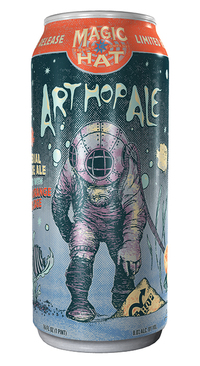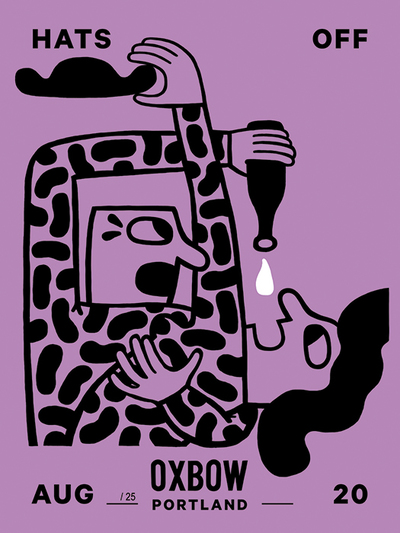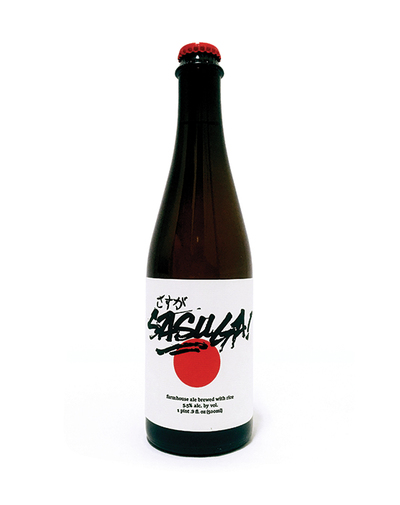Sensory Delights: Libations and Their Labels

Above: Before and after images of artwork to can. Zelde Grimm, Magic Hat Art Hop Ale 2015, mixed media.
Wineries, breweries and distilleries have been capitalizing on our aesthetic sense for decades. But as art enters more and more into our public lives, and as our culture becomes increasingly visually literate, more companies are tempting our palate with an appeal to our eyes, and they’re tapping professional artists for the job.
In 2016, Vermont-based artist Zelde Grimm saw one of her dark and whimsical underwater illustrations curled around cans of Magic Hat’s Art Hop Ale. She was the winner of the company’s annual Labels for Libation contest, which asks artists to partner with the brewery in promoting the work of SEBA, a local art-based nonprofit. One of the reasons Grimm enjoys working with Magic Hat, she says, is because they are far more open to her artistic input than the average commercial venture. “I can’t think of any other packaging so capable of being this free-form,” she says. Aside from providing Grimm with a general theme and a few basic guidelines (the image does have to appear on a bottle with set dimensions and can only be printed with six colors), Grimm is free to create the work she wants.
In addition to seeing her distinctive storybook style of art on cans of beer, Grimm also created a show for the Magic Hat gallery inside the brewery in their sprawling event space known locally as the “Artifactory.” The name is a nod to the company’s interest in the arts, including both visual and performance. (A fall 2016 gallery exhibit called Ninety-Nine Bottles featured work from over 20 local artists displayed on bottle-shaped canvases.) Similarly, Oxbow Brewing Company’s tasting and bottling center in Portland, ME, also houses a gallery, which features the work of local painters, printmakers and illustrators, including Keith Shore, Richard Keene and Janine Grant. Since founding the company in 2011, owner Tim Adams has employed Maine-based artist Will Sears as their in-house artist. Sears is responsible for creating label designs, murals and curating the funky downtown gallery. “Will’s aesthetic creativity inspires my creative process every day,” says Adams. “Both of our production spaces are filled with his artwork and provide a stimulating environment in which to create our beers.”
Brewers weren’t the first to recognize the benefits of artistic labels. Winemaker Baron Philippe de Rothschild is widely credited for pioneering the trend. Back in 1924, he illustrated a bottle with a bold cubist-inspired painting of a ram’s head by French artist and graphic designer Jean Carlo. The winery continued working with artists including Pablo Picasso, Andy Warhol, Salvador Dalí and others to help brand their products.
American vineyards followed suit. A 2016 exhibit at American Museum of Fly Fishing in Manchester, VT, features a series of nature-inspired wine labels that depict scenes familiar to any fisherman. “The exhibition is designed to take you from original artwork to label to bottle,” says Peter Nardini, museum communications coordinator. “You see all three elements together—painting, label and finished bottle—which gives you a real appreciation for the work of art and how it was transformed.” Yoshi Akiyama, curator for the museum, says the strength of the exhibit comes from the interplay between winery and artist and their shared appreciation for the natural world. “I always thought winemakers cared about great-tasting wine, but we didn’t know—not until we got the collection of labels a few years back—that they also cared so much about the environment.” As Akiyama explains, these partnerships weren’t just about selling bottles of vino. In many instances, they were also designed to help raise funds and awareness for environmental issues.

Keith Shore, Hats Off, 2016, screen print, 18 x 24″. Exhibited at Oxbow Brewery in August 2016.
“People who come to the museum are interested in more than catching big fish,” Akiyama says. “They’re concerned about the environment.” Idaho’s Hells Canyon Winery, for instance, partnered with artist Fred W. Thomas to create a special series of wines featuring images of fly rods, fish and reels. Since 1998, ten percent of net profits from their sales have been donated to wildlife conservation. Like all artistic alcoholic collaborations, this series of bottles served multiple purposes. It was a shrewd branding effort intended to help sell bottles of wine, and thus help Hells Canyon turn a profit (the fishing scenes turned out to be particularly popular as holiday gifts), but it was also a way for vineyard owner Steve Robertson to broadcast a message about his personal values.
This is equally true for brewers, who use their brightly colored labels and in-house galleries to send a message to consumers about their company’s participation in the local art scene. Many craft brewers are small, highly creative operations, which make them natural allies with other independent makers. “We’re proud to pay the artists 100 percent for all work sold,” Adams says. Artists represented by conventional galleries typically receive only 50 percent of the profits, making the Oxbow tasting room an outlier not only in format, but also in earning potential.
According to Henry Kahn, Magic Hat marketing manager, the decision to work with artists stems in part from a desire to push boundaries. “Magic Hat is all about pioneering new flavors and ideas. We’re known for coming up with some pretty interesting recipes,” he says, citing the beet-infused and pink-hued Wacko as an example of this trend. “We look for that same ethos when we’re picking the artists for our gallery. We want people who put themselves out there and speak in an unfettered voice.”

Will Sears, Sasuga label, 2016, letterpress printed by Checker Press, 3½ x 6½”. Photo: Will Sears.
While Sears is quick to admit that his work with Oxbow is very different from his fine art pieces, he believes in keeping his commercial work separate from his more visually challenging assemblage creations. He also feels proud to be part of the collaborative process.
Alcoholic beverages, Sears argues, are often “something you treat yourself to at the end of a long week.” This is particularly true of luxury items like craft brews or fine wines. “The first taste you have is with your eyes. If I can be part of the experience of these products that the brewers and winemakers feel proud of creating, I don’t want my half of things to fall short,” Sears says.
“I wouldn’t say I’m healing the world,” he adds, “but I might make your Friday night a little bit better, if all goes well.” We’ll drink to that.
Katy Kelleher is a writer, editor, and teacher who lives in a small log cabin in the woods of Buxton, ME. Her first book, Handcrafted Maine, is due out in July from Princeton Architectural Press.

